High school teachers’ pedagogical beliefs in English as a foreign language writing instruction
Writing in a foreign language is deemed to be the most difficult language skill to learners, especially at high school level. Consequently, its teaching has become a challenging task for high school teachers in the Vietnamese context. Teacher beliefs related literature indicates that what teachers do in the classroom is directly governed by what they think and believe. Thereby, the current study adopted features of a survey research design to examine the English as a Foreign Language (EFL) high school teachers’ beliefs about writing and its teaching. A sample of seventy six EFL teachers from the eight selected high schools situated in Ho Chi Minh City was recruited for the current survey. The beliefs of EFL writing instruction of these teachers were elicited through two instruments of eighteen–item questionnaires and semi–structured interviews. Then the questionnaires were quantitatively analyzed and the interviews were qualitatively analyzed. Results of the study showed that most of the participants held different orientations about writing skill, teacher roles and its teaching. The study was closed by a brief conclusion of key findings
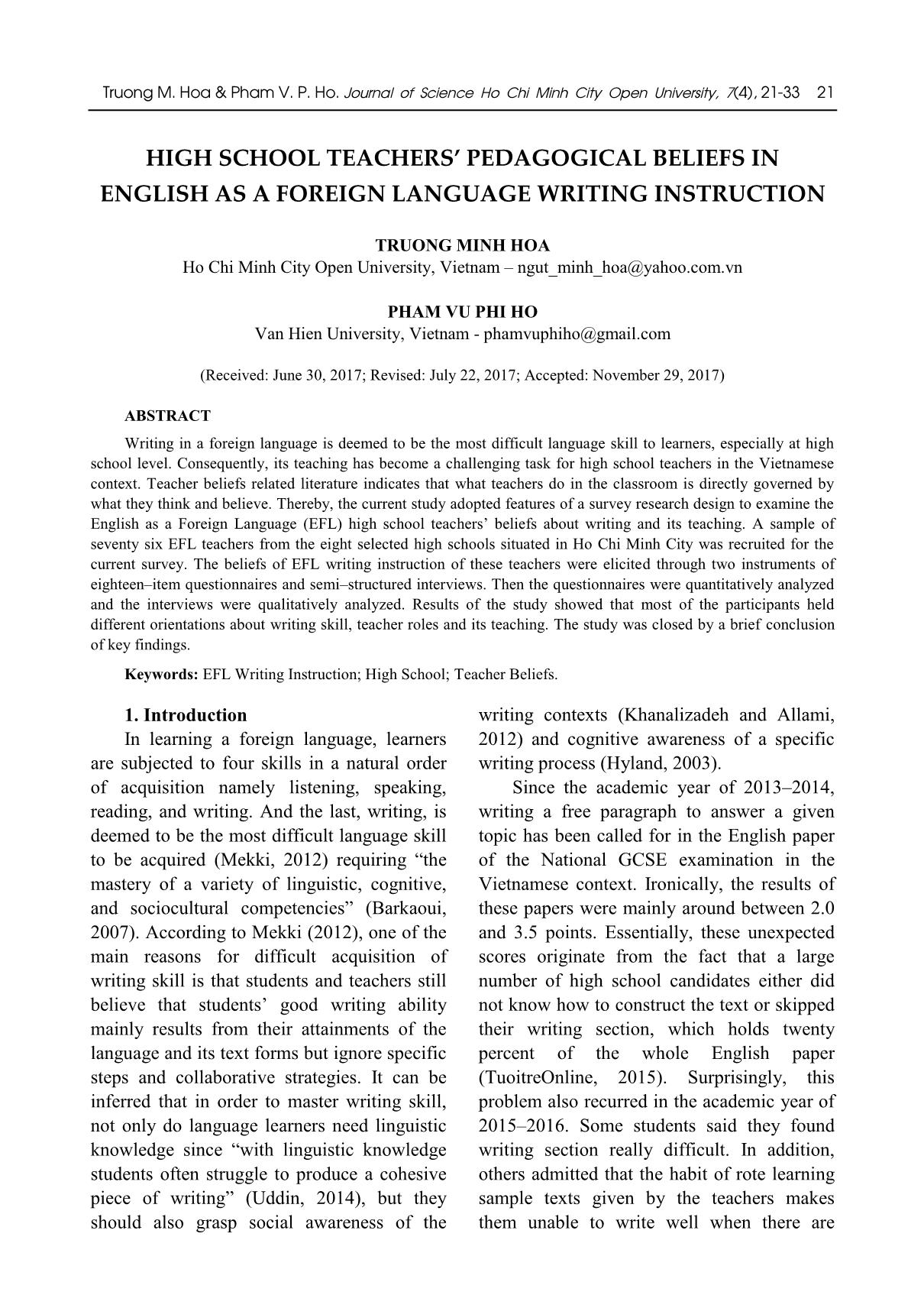
Trang 1
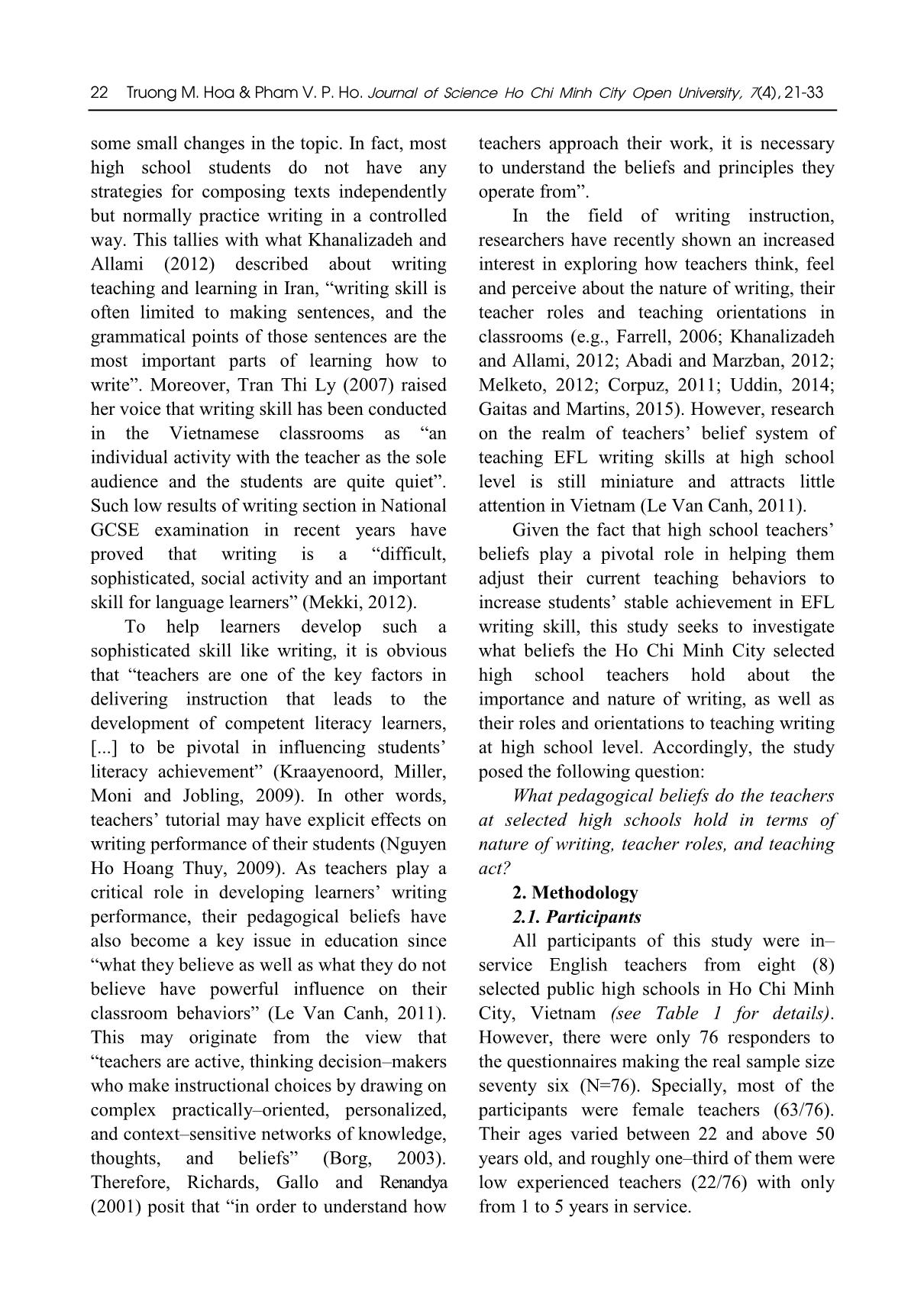
Trang 2
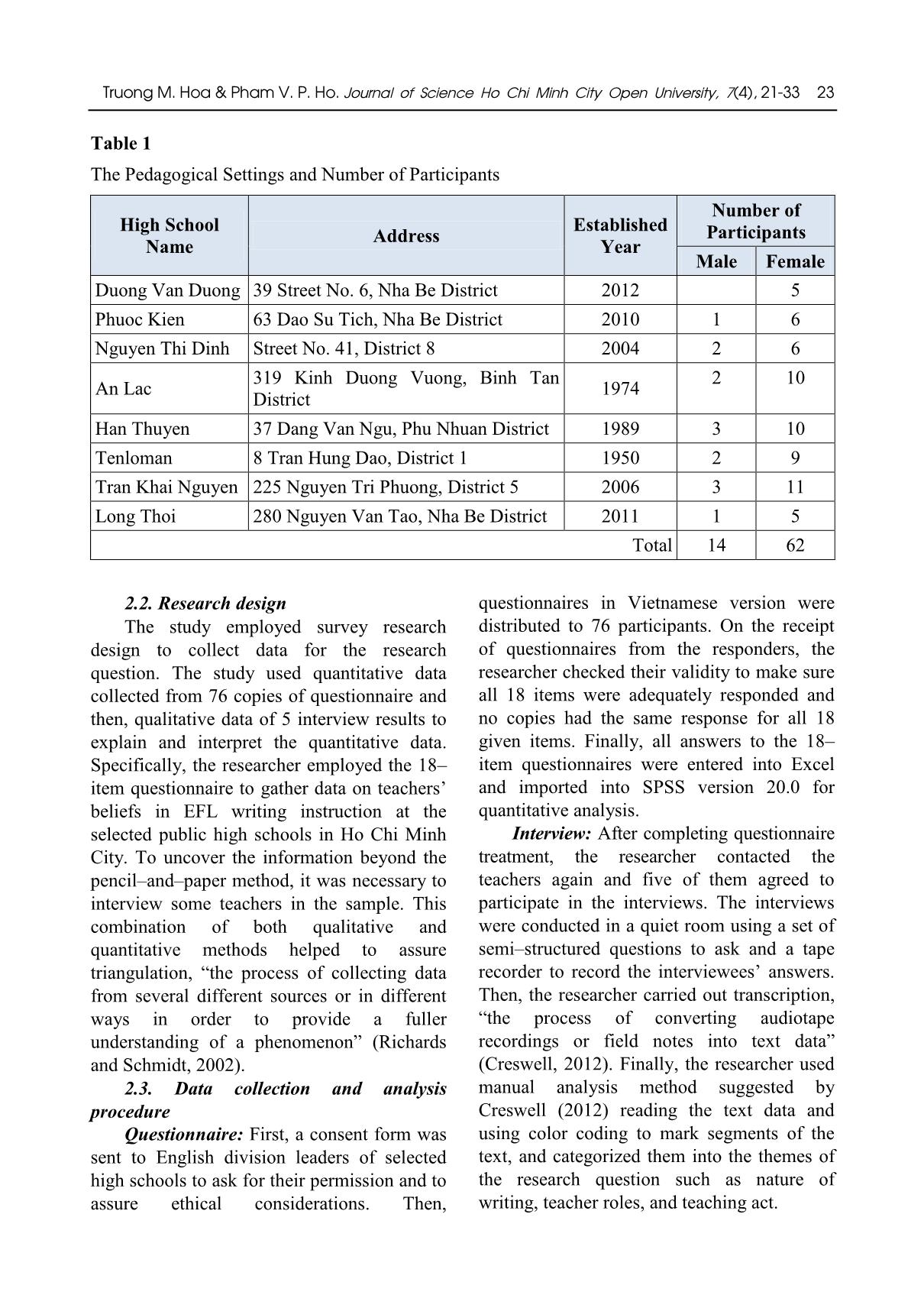
Trang 3
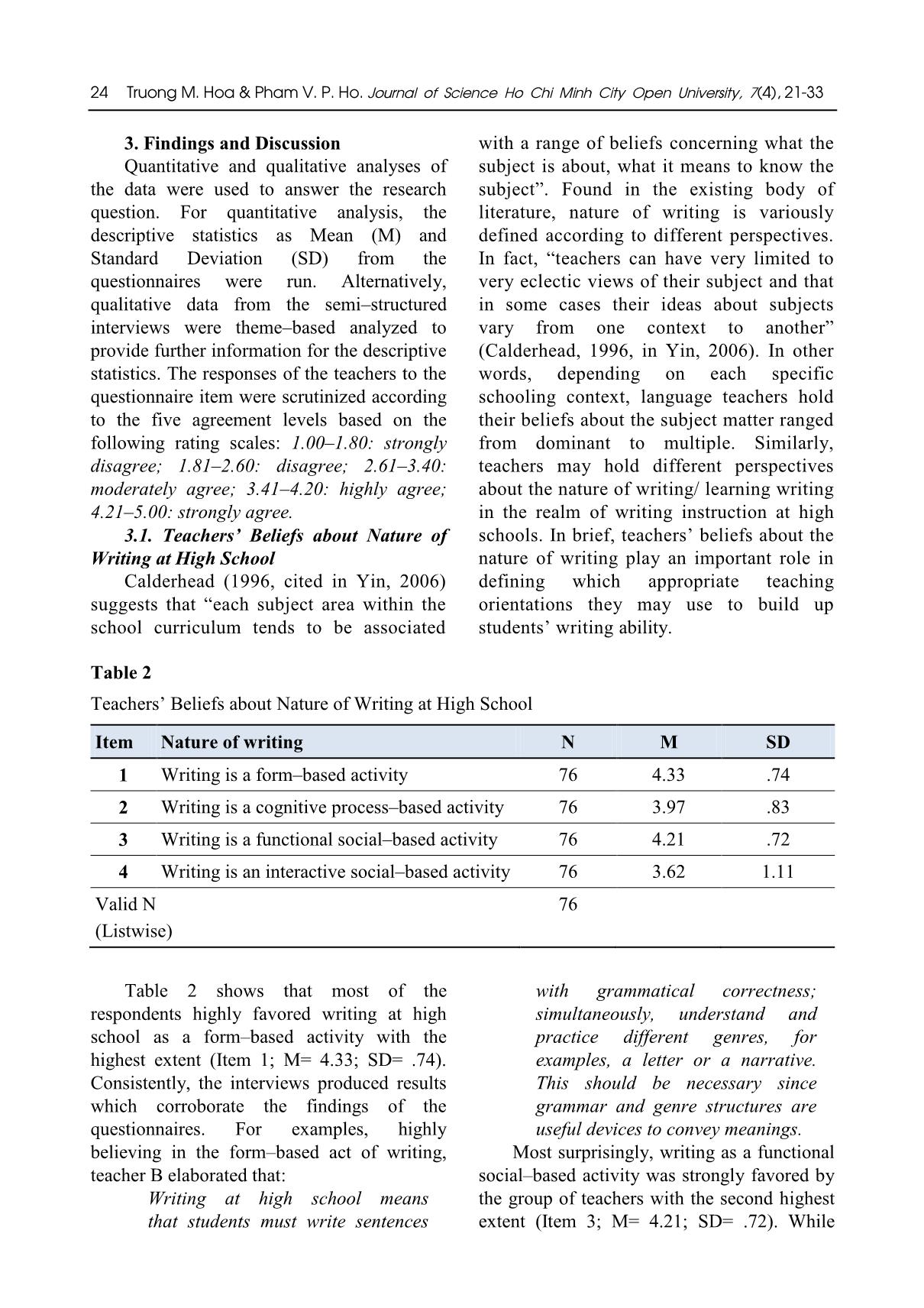
Trang 4
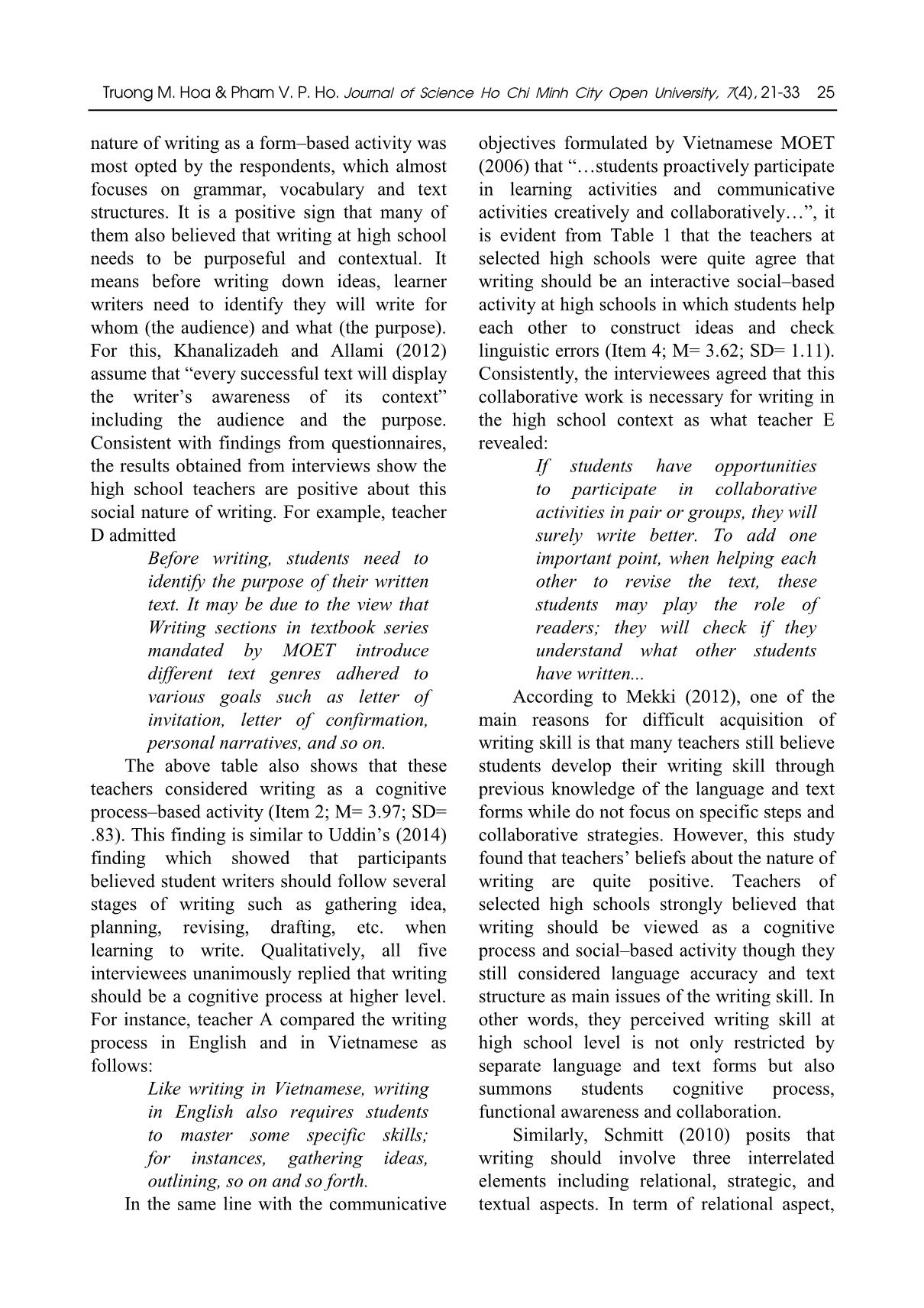
Trang 5
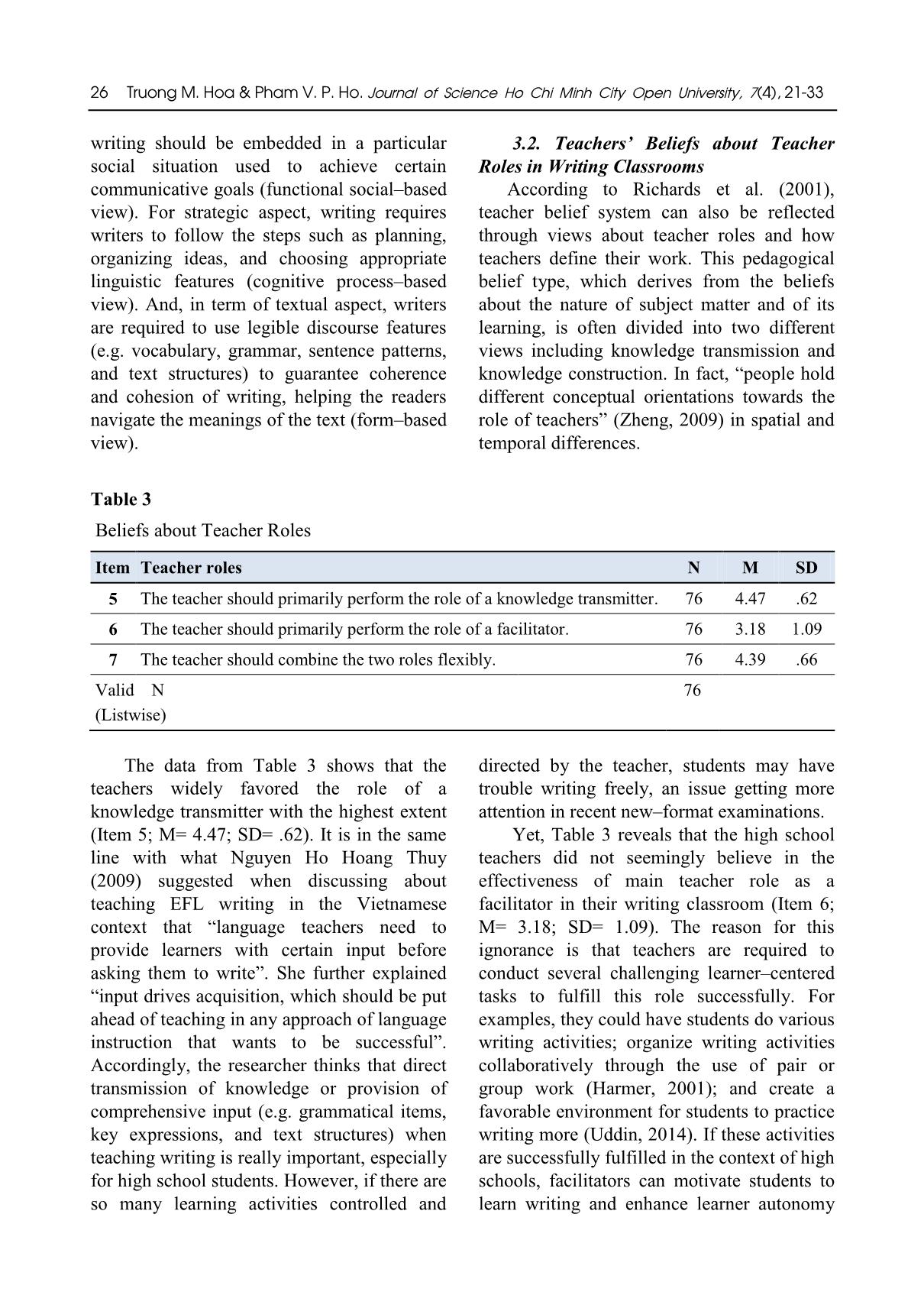
Trang 6
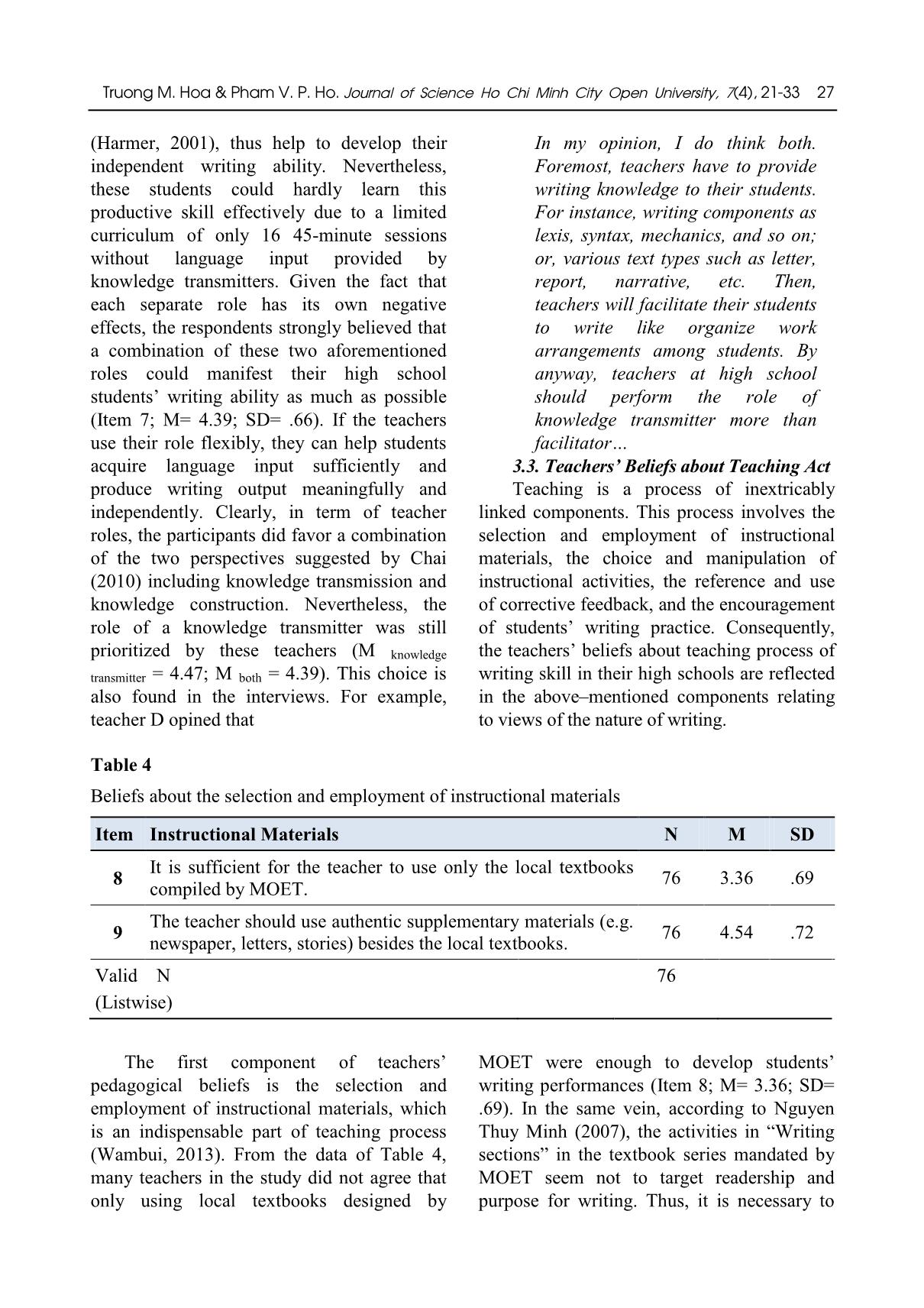
Trang 7
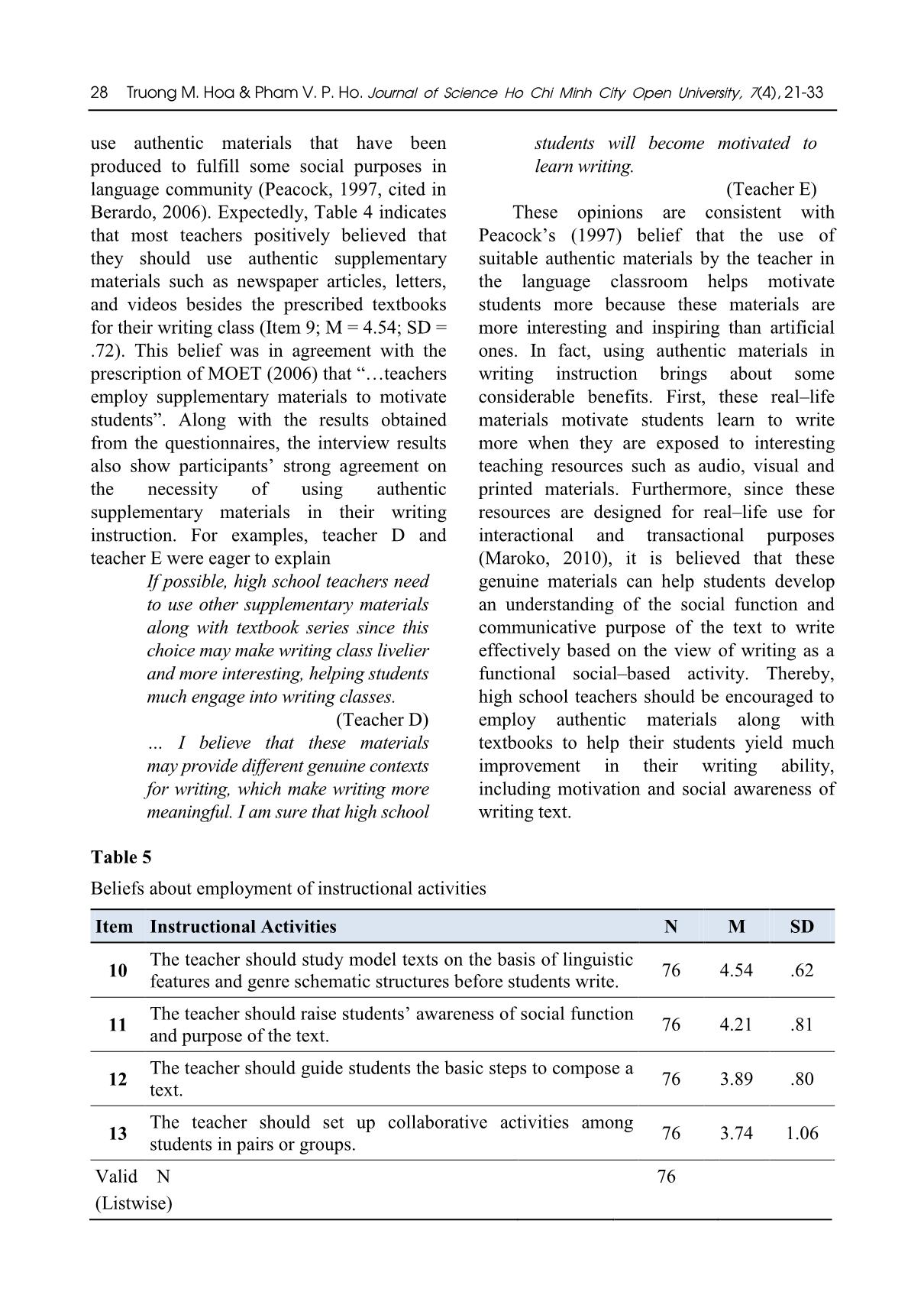
Trang 8
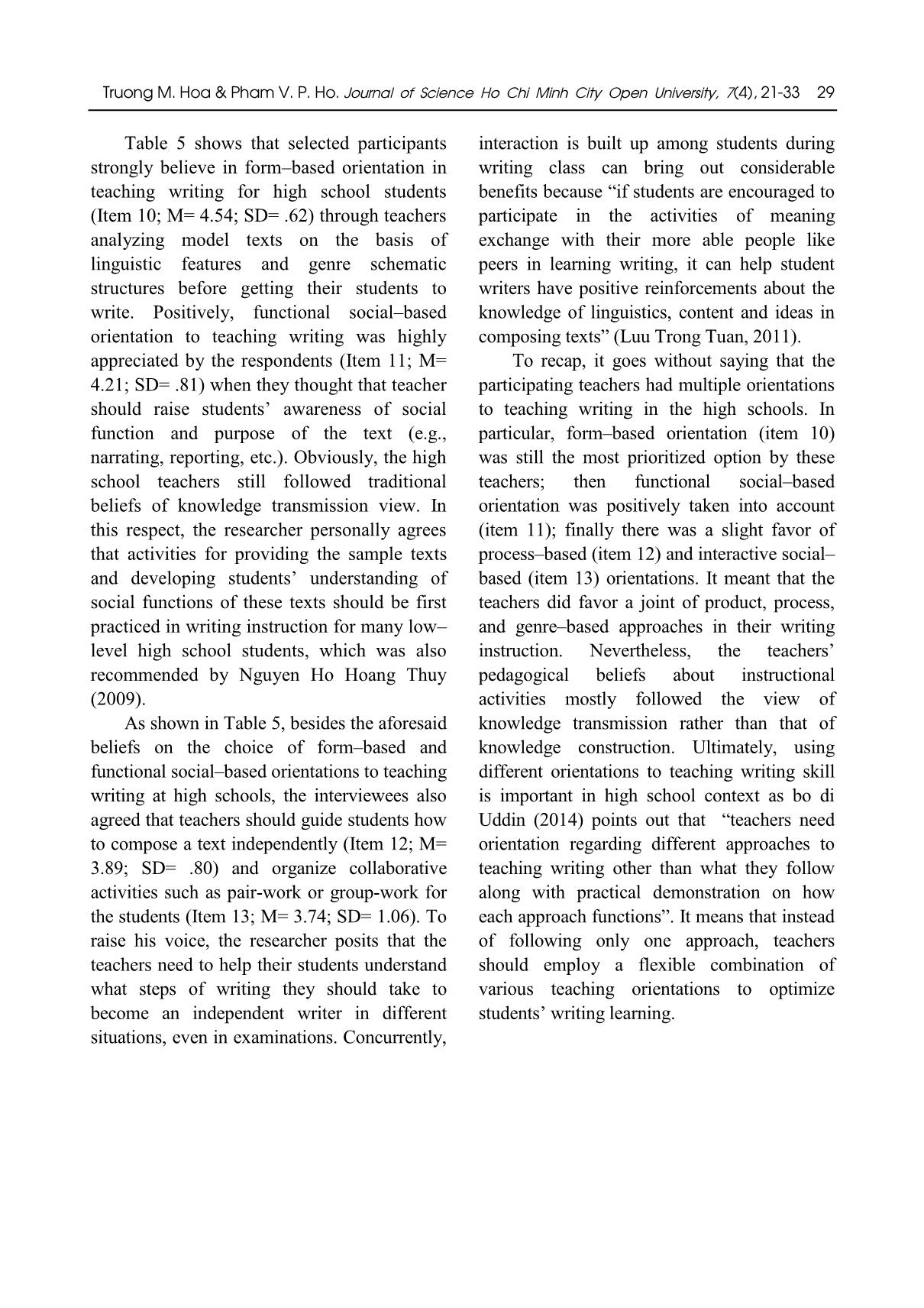
Trang 9
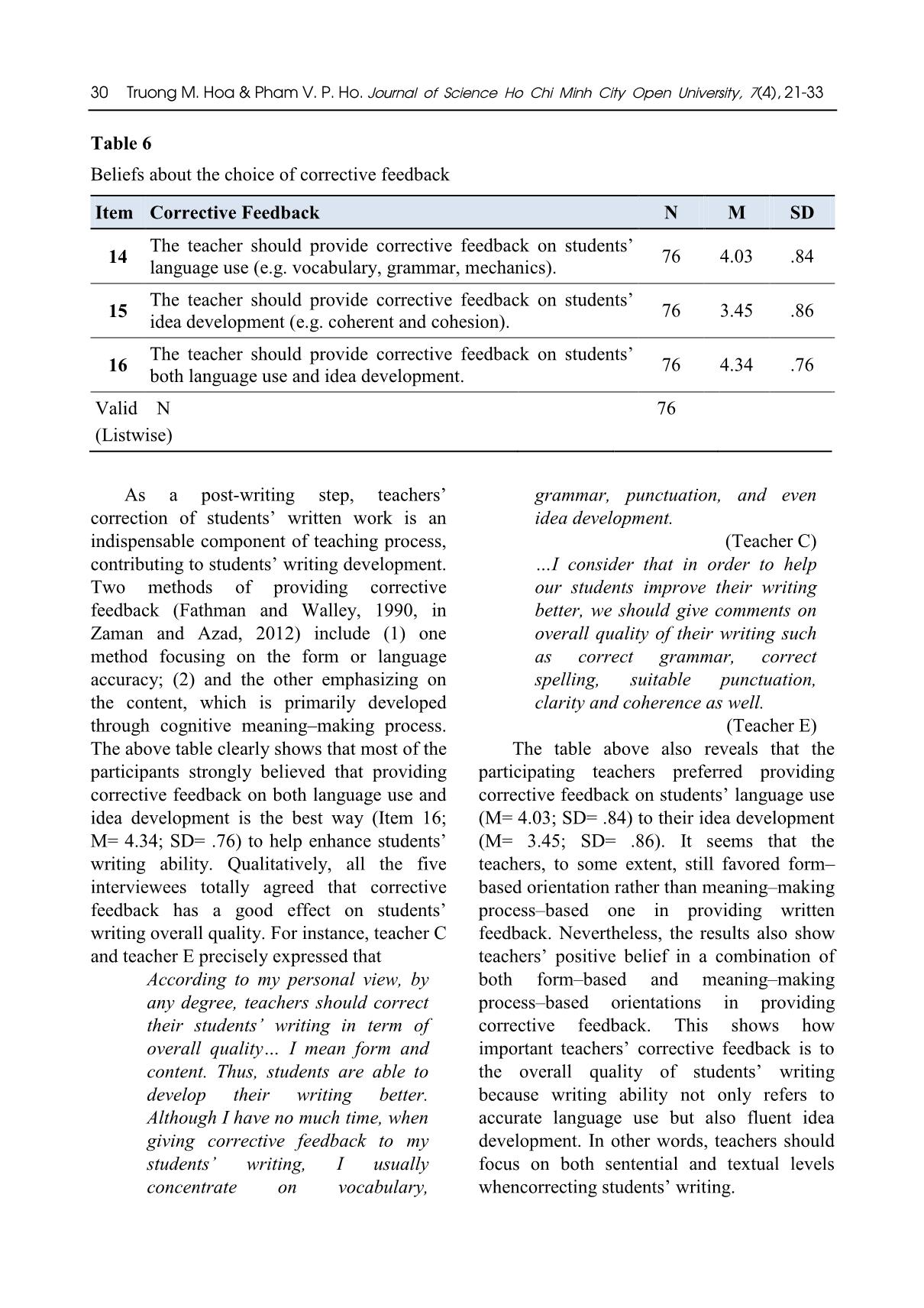
Trang 10
Tải về để xem bản đầy đủ
Tóm tắt nội dung tài liệu: High school teachers’ pedagogical beliefs in English as a foreign language writing instruction
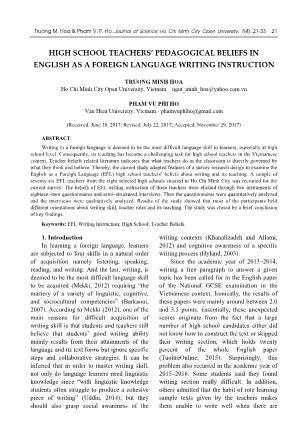
Truong M. Hoa & Pham V. P. Ho. Journal of Science Ho Chi Minh City Open University, 7(4), 21-33 21 HIGH SCHOOL TEACHERS’ PEDAGOGICAL BELIEFS IN ENGLISH AS A FOREIGN LANGUAGE WRITING INSTRUCTION TRUONG MINH HOA Ho Chi Minh City Open University, Vietnam – ngut_minh_hoa@yahoo.com.vn PHAM VU PHI HO Van Hien University, Vietnam - phamvuphiho@gmail.com (Received: June 30, 2017; Revised: July 22, 2017; Accepted: November 29, 2017) ABSTRACT Writing in a foreign language is deemed to be the most difficult language skill to learners, especially at high school level. Consequently, its teaching has become a challenging task for high school teachers in the Vietnamese context. Teacher beliefs related literature indicates that what teachers do in the classroom is directly governed by what they think and believe. Thereby, the current study adopted features of a survey research design to examine the English as a Foreign Language (EFL) high school teachers’ beliefs about writing and its teaching. A sample of seventy six EFL teachers from the eight selected high schools situated in Ho Chi Minh City was recruited for the current survey. The beliefs of EFL writing instruction of these teachers were elicited through two instruments of eighteen–item questionnaires and semi–structured interviews. Then the questionnaires were quantitatively analyzed and the interviews were qualitatively analyzed. Results of the study showed that most of the participants held different orientations about writing skill, teacher roles and its teaching. The study was closed by a brief conclusion of key findings. Keywords: EFL Writing Instruction; High School; Teacher Beliefs. 1. Introduction In learning a foreign language, learners are subjected to four skills in a natural order of acquisition namely listening, speaking, reading, and writing. And the last, writing, is deemed to be the most difficult language skill to be acquired (Mekki, 2012) requiring “the mastery of a variety of linguistic, cognitive, and sociocultural competencies” (Barkaoui, 2007). According to Mekki (2012), one of the main reasons for difficult acquisition of writing skill is that students and teachers still believe that students’ good writing ability mainly results from their attainments of the language and its text forms but ignore specific steps and collaborative strategies. It can be inferred that in order to master writing skill, not only do language learners need linguistic knowledge since “with linguistic knowledge students often struggle to produce a cohesive piece of writing” (Uddin, 2014), but they should also grasp social awareness of the writing contexts (Khanalizadeh and Allami, 2012) and cognitive awareness of a specific writing process (Hyland, 2003). Since the academic year of 2013–2014, writing a free paragraph to answer a given topic has been called for in the English paper of the National GCSE examination in the Vietnamese context. Ironically, the results of these papers were mainly around between 2.0 and 3.5 points. Essentially, these unexpected scores originate from the fact that a large number of high school candidates either did not know how to construct the text or skipped their writing section, which holds twenty percent of the whole English paper (TuoitreOnline, 2015). Surprisingly, this problem also recurred in the academic year of 2015–2016. Some students said they found writing section really difficult. In addition, others admitted that the habit of rote learning sample texts given by the teachers makes them unable to write well when there are 22 Truong M. Hoa & Pham V. P. Ho. Journal of Science Ho Chi Minh City Open University, 7(4), 21-33 some small changes in the topic. In fact, most high school students do not have any strategies for composing texts independently but normally practice writing in a controlled way. This tallies with what Khanalizadeh and Allami (2012) described about writing teaching and learning in Iran, “writing skill is often limited to making sentences, and the grammatical points of those sentences are the most important parts of learning how to write”. Moreover, Tran Thi Ly (2007) raised her voice that writing skill has been conducted in the Vietnamese classrooms as “an individual activity with the teacher as the sole audience and the students are quite quiet”. Such low results of writing section in National GCSE examination in recent years have proved that writing is a “difficult, sophisticated, social activity and an important skill for language learners” (Mekki, 2012). To help learners develop such a sophisticated skill like writing, it is obvious that “teachers are one of the key factors in delivering instruction that leads to the development of competent literacy learners, [...] to be pivotal in influencing students’ literacy achievement” (Kraayenoord, Miller, Moni and Jobling, 2009). In other words, teachers’ tutorial may have explicit effects on writing performance of their students (Nguyen Ho Hoang Thuy, 2009). As teachers play a critical role in developing learners’ writing performance, their pedagogical beliefs have also become a key issue in education since “what they believe as well as what they do not believe have powerful influence on their classroom behaviors” (Le Van Canh, 2011). This may originate from the view that “teachers are active, thinking decision–makers who make instructional choices by drawing on complex practically–oriented, personalized, and context–sensitive networks of knowledge, thoughts, and beliefs” (Borg, 2003). Therefore, Richards, Gallo and Renandya (2001) posit that “in order to understand how teachers approach their work, it is necessary to understand the beliefs and principles they operate from”. In the field of writing instruction, researcher ... 14 The teacher should provide corrective feedback on students’ language use (e.g. vocabulary, grammar, mechanics). 76 4.03 .84 15 The teacher should provide corrective feedback on students’ idea development (e.g. coherent and cohesion). 76 3.45 .86 16 The teacher should provide corrective feedback on students’ both language use and idea development. 76 4.34 .76 Valid N (Listwise) 76 As a post-writing step, teachers’ correction of students’ written work is an indispensable component of teaching process, contributing to students’ writing development. Two methods of providing corrective feedback (Fathman and Walley, 1990, in Zaman and Azad, 2012) include (1) one method focusing on the form or language accuracy; (2) and the other emphasizing on the content, which is primarily developed through cognitive meaning–making process. The above table clearly shows that most of the participants strongly believed that providing corrective feedback on both language use and idea development is the best way (Item 16; M= 4.34; SD= .76) to help enhance students’ writing ability. Qualitatively, all the five interviewees totally agreed that corrective feedback has a good effect on students’ writing overall quality. For instance, teacher C and teacher E precisely expressed that According to my personal view, by any degree, teachers should correct their students’ writing in term of overall quality I mean form and content. Thus, students are able to develop their writing better. Although I have no much time, when giving corrective feedback to my students’ writing, I usually concentrate on vocabulary, grammar, punctuation, and even idea development. (Teacher C) I consider that in order to help our students improve their writing better, we should give comments on overall quality of their writing such as correct grammar, correct spelling, suitable punctuation, clarity and coherence as well. (Teacher E) The table above also reveals that the participating teachers preferred providing corrective feedback on students’ language use (M= 4.03; SD= .84) to their idea development (M= 3.45; SD= .86). It seems that the teachers, to some extent, still favored form– based orientation rather than meaning–making process–based one in providing written feedback. Nevertheless, the results also show teachers’ positive belief in a combination of both form–based and meaning–making process–based orientations in providing corrective feedback. This shows how important teachers’ corrective feedback is to the overall quality of students’ writing because writing ability not only refers to accurate language use but also fluent idea development. In other words, teachers should focus on both sentential and textual levels whencorrecting students’ writing. Truong M. Hoa & Pham V. P. Ho. Journal of Science Ho Chi Minh City Open University, 7(4), 21-33 31 Table 7 Beliefs about the encouragement of students’ writing practice Item Students’ extensive writing N M SD 17 The teacher only need to have students to complete writing tasks exposed in the textbooks. 76 3.82 .69 18 The teacher should create a favorable environment for students to write a lot. 76 4.49 .77 Valid N (Listwise) 76 “Practice makes perfect” is a theme that teachers should observe to give their high school students more chances to practice writing. According to Herder and King (2012, cited in Pham, Vu Phi Ho, 2013), just inside- the-classroom activities are not enough for students to practice and improve their writing. Thus, Uddin (2014) requests students should be asked to join out–of–class writing activities more as all the steps of writing process could not be fully accomplished within classrooms. Positively, Table 7 reveals that the participants widely agreed that teachers should create more favorable environments for students to practice writing (Item 18; M= 4.49; SD= .77) rather than letting them do controlled practices in the textbooks (Item 17; M= 3.82; SD= .69). By this way, students could manipulate various stages of the writing process such as idea brainstorming, idea organizing, and appropriate linguistic selecting by themselves. Parallel with this quantitative finding, all the five interviewees also agreed that it is necessary to offer students more writing practice; typically, “the more my students practice, the more their writing skill is improved” (Teacher B). In other words, it is even better to assign homework on similar topic and text types for students because “practice makes perfect”. Through homework writing assignments, the cognitive processes can be done in a more comfortable way because the stages of the writing process could not be fully completed in an environment with temporal limit and rigid curriculum as in the classroom. I find it crucial for language teachers to assign their students some topics to write at home. You know, if writing at home, students will become more comfortable without time pressure. Secondly, when writing at home, these students will have much time to accomplish steps of writing process such as collecting ideas, outlining them, editing spelling, grammatical mistakes, except for cases that they copy the sample texts down from online resources. (Teacher A) 4. Conclusion 4.1. Teachers’ beliefs about the nature of writing in the high school context Unsurprisingly, the teachers of the eight selected high schools strongly believed that language accuracy and text structure are the main concerns of writing. However, it seems most surprising that many of them also positively admitted the functional social– based aspect of writing, which deals with the target audience, communicative purposes and situational context of writing. In addition, some teachers somehow believed that writing is best acquired through meaning–making process as well as through interactions among students. In short, these high school teachers’ beliefs about nature of writing were quite multiple. Accordingly, they perceived writing skill at high school level is not only restricted 32 Truong M. Hoa & Pham V. P. Ho. Journal of Science Ho Chi Minh City Open University, 7(4), 21-33 by separate language and text forms but also summons students much cognitive process and functional awareness and collaboration. This tallies with previous studies on the nature of writing by Schmitt (2010), Mekki (2012), Khanalizadeh and Allami (2012), and Uddin (2014). 4.2. Teachers’ beliefs about teacher roles in writing classrooms Most of the participants agreed that language teachers must be a direct knowledge transmitter to give learners some input before asking them to write instead of letting them totally relying on the teacher as the main facilitator in the writing classrooms. This is a good way to help students write better. A combination and flexibility of the above teacher roles were highly appreciated by a large number of the participating teachers. 4.3. Teachers’ beliefs about teaching act With respect to instructional materials, the teachers highly appreciated that employing authentic supplementary materials along with the prescribed textbooks is necessary because they considerably contribute to developing students’ awareness of social contexts and functions of different writing text types. Regarding instructional activities, the selected participants strongly believed that form–based orientation to teaching writing should be used by studying model texts on the basis of linguistic features and genre schematic structures before having students write. Noticeably, functional social–based orientation to teaching writing was also highly favored by the teachers as a necessity to raise students’ awareness of social functions and purposes of writing. Besides, the teachers agreed, to some extent, that collaborative activities such as pairs/groups (interactive social–based orientation) or instruction on composing a text independently (cognitive process–based orientation) should be often held in writing classes. As for corrective feedback, many strongly believed that providing feedback on the overall quality of students’ writing is the best way to help improve their writing skill. In terms of each separate aspect, the study found that language accuracy surpasses idea fluency. For extensive writing practice of students, most participants strongly applauded that practicing writing on the same topics and text types outside the classroom is an ideal way for teaching writing based on the motto “practice makes perfect”. Thus, writing steps can be practiced in a more comfortable way with no time pressure References Abadi, M. K. S., & Marzban, A. (2012). Teachers’ Beliefs and Teaching English Writing to Children and Adolescent Learners in Iran. Journal of Academic and Applied Studies, 2(6), 23–31. Barkaoui, K. (2007). Teaching writing to second language learners: Insights from theory and research. TESL Reporter, 40(1), 35–48. Berardo, S. A. (2006). The Use of Authentic Materials in the Teaching of Reading. The Reading Matrix, 6(2), 60–69. Borg, S. (2003). Teacher cognition in language teaching: A review of research on what language teachers think, know, believe, and do. Language Teaching, 38, 81–109. Chai, C. S. (2010). Teachers’ Epistemic Beliefs and Their Pedagogical Beliefs: A Qualitative Case Study among Singaporean Teachers in the Context of ICT–Supported Reforms. The Turkish Online Journal of Educational Technology, 9(4), 128–139. Corpuz, V. A. F. S. (2011). Error correction in second language writing: Teachers’ beliefs, practices, and students’ preferences [Unpublished master's thesis]. Queensland University of Technology. Creswell, J. W. (2012). Educational research: Planning, conducting, and evaluating quantitative (4 th ed.). Boston, MA: Pearson Education. Truong M. Hoa & Pham V. P. Ho. Journal of Science Ho Chi Minh City Open University, 7(4), 21-33 33 Farrell, T. S. C. (2006). Reflective Practice in Action: A Case Study of a Writing Teacher’s Reflections on Practice. ESL Canada Journal, 23(2), 77–90. Gaitas, S. & Martins, M. A. (2015). Relationships between primary teachers’ beliefs and their practices in relation to writing instruction. Research Papers in Education, 30(4), 492–505. Harmer, J. (2001). The practice of English language teaching. Essex, England: Longman. Hyland, K. (2003). Second language writing. Cambridge: Cambridge University Press. Khanalizadeh, B., & Allami, H. (2012). The Impact of Teachers’ Belief on EFL Writing Instruction. Theory and Practice in Language Studies, 2(2), 334–342. Kraayenoord, C. E. V., Miller, R., Moni, K. B., & Jobling, A. (2009). Teaching writing to students with learning difficulties in inclusive English classrooms: Lessons from an exemplary teacher. English Teaching: Practice and Critique, 8(1), 23–51. Le Van Canh (2011). Form–Focused Instruction: A Case Study of Vietnamese Teachers’ Beliefs and Practices [Unpublished doctoral thesis]. Luu Trong Tuan (2011). Teaching writing through genre–based approach. BELT Journal, 2(1), 121–136. Maroko, G. M. (2010). The authentic materials approach in the teaching of functional writing in the classroom. In: Reinelt, R. (Ed.). The new decade and (2 nd ) FL Teaching: The initial phase, Rudolf Reinelt Research Laboratory EU Matsuyama, Japan, 71–87. Mekki, C. (2012). The student awareness of writing skill: The case study third year students at Biskra University [Unpublished master's thesis]. Ministry of Education and Training (2006). The English curriculum for the secondary school. Hanoi: Education Publisher. Nguyen Ho Hoang Thuy (2009). Teaching EFL writing in Vietnam: Problems and solutions–a discussion from the outlook of applied linguistics. VNU Journal of Science, Foreign Languages 25, 61–66. Nguyen Thuy Minh (2007). Textbook evaluation: the case of English textbooks currently in use at Vietnam’s upper– secondary school [Unpublished research report]. Singapore: RELC SEAMEO. Pham Vu Phi Ho (2013). Teaching Activities Employed in the Writing Classrooms at the FFL at HCMCOU. Journal of Science Ho Chi Minh City Open University, 3(31), 96–115. Richards, J. C., Gallo, P. B., & Renandya, W. A. (2001). Exploring Teachers’ Beliefs and the Process of Change. The APC Journal, 1(1), 42–64. Richards, J. C., & Schmidt, R. (2002). Longman dictionary of language teaching and applied linguistics. London, UK: Longman: Pearson Education. Schmitt, N. (2010). An introduction to Applied Linguistics (2 nd ed.). London, England: Hodder Education. Tran Thi Ly (2007). Learners’ motivation and identity in the Vietnamese EFL writing classroom. English Teaching: Practice and Critique, 6(1), 151–163. Uddin, M. E. (2014). Teachers’ Pedagogical Belief and its Reflection on the Practice in Teaching Writing in EFL Tertiary Context in Bangladesh. Journal of Education and Practice, 5(29), 116–129. Wambui, S. E. (2013). Effects of use of instructional materials on learner participation in science classroom in preschool in Kiine zone Kirinyaga country Kenya. Nairobi: University press, Nairobi. Yin, W. K. (2006). Teacher beliefs and grammar teaching practices: Case studies of four ESL teachers [Unpublished doctoral thesis]. The University of Hong Kong. Zaman, M. M., & Azad, M. A. K. (2012). Feedback in EFL Writing at Tertiary Level: Teachers' and Learners’ Perceptions. ASA University Review, 6(1). Zheng, H. (2009). A Review of Research on EFL Pre–Service Teachers’ Beliefs and Practices. Journal of Cambridge Studies, 4(1), 73–81.
File đính kèm:
 high_school_teachers_pedagogical_beliefs_in_english_as_a_for.pdf
high_school_teachers_pedagogical_beliefs_in_english_as_a_for.pdf

